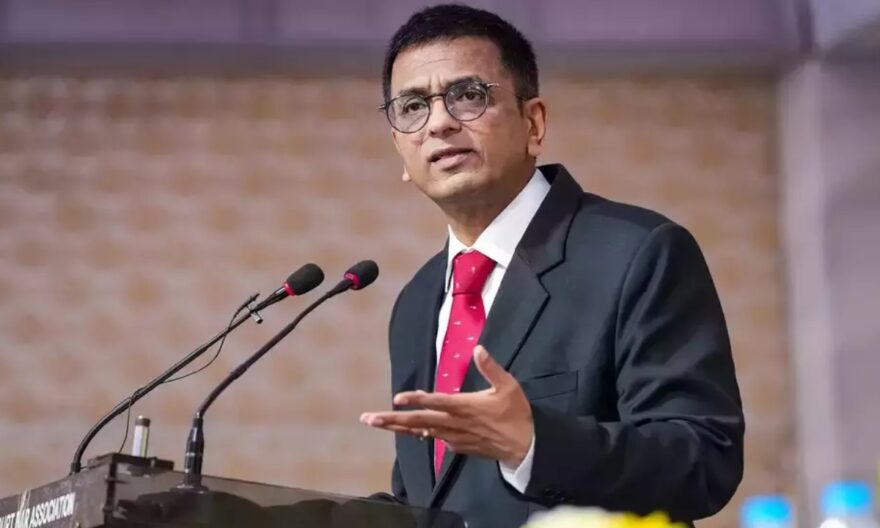
Chief Justice of India DY Chandrachud on Saturday stated at IIT Madras that “While Artificial Intelligence is the buzzword these days, it has its flip sides and can end up being a tool to perpetuate discrimination.”
The CJI cited AI recruitment tools favoring men over women as an example.
He explained that, “AI can also undermine right to fair treatment and perpetuate discrimination. many AI systems have shown prejudiced decision-making based on data inputs that show societal prejudices. For eg: AI recruitment tools deployed by firms preferred men over women because the tools were trained on the profile of successful employees who, for gendered reasons, were males.”
CJI cautioned that AI can also end up causing harm to people and society in its real-world application.
Further, he said, “Today Artificial Intelligence are the two words on everybody’s lips, and AI is being deployed to increase computer efficiency. In a relatively short time, AI tools such as ChatGPT has shown that even a computer can crack a joke or finish a task. Even in the Supreme Court, we are using AI on a pilot basis. Always remember what values AI creates and what affordances it creates. I have been fascinated with AI image-generating software, which allows you to insert written prompt and generate an image, but I am also aware how it may be used to create fakes to mislead, to threaten, and to bully.”
The CJI emphasized that technology must not create fear of online abuse or harassment, as it hinders the free expression of thoughts.
The CJI made these remarks during the 60th Convocation Ceremony of the Indian Institute of Technology Madras in Chennai.
At the beginning of his speech, the CJI acknowledged and praised the significant contributions of IIT Madras to research and development in the country.
The CJI initiated his address by raising a fundamental question about the principled values that technology embodies.
“It is often said technology develops at a speed with which the law cannot keep up with. This may seem true in the heat of the moment, but if we take a step back, our history would be a testament to the fact that technological developments share a dialectic relationship. At one point in time in history, ships were considered the epitome of technological evolution but with every voyage there was a risk of losing goods and human lives. It was the law of corporate ownership and financing that helped businesses to manage the risk of overseas voyages.”
The CJI further elaborated on how virtual court hearings, necessitated by the COVID-19 pandemic, shed light on the challenges female lawyers previously encountered while physically appearing in court, given the gendered demands of caregiving and domestic work.
He opined, “With video-conferencing (VC), they could argue from their homes. VC helped in live-streaming of Constitution bench proceedings. Here the values of video-conference extend beyond mere communication and encompass inclusiveness and access to justice.”
The CJI referenced the recently-released biopic of Robert Oppenheimer to emphasize that technological evolution doesn’t occur in a social vacuum; instead, it is intricately woven into societal realities, legal frameworks, economic factors, and political structures.
The CJI stated, “A key architect of the atomic bomb, he later sought a ban on nuclear bomb and creation of larger bombs not to acclaim or denounce them but recognize the impact of theoretical science in the real world. No technology is neutral and when deployed in real world it fulfills certain human values.”
Also, the CJI touched upon the looming fear of surveillance through technology.
He stated, “With the advent of emails, you may never know that your email is being intercepted and while electronic communication shows values of communication and collaboration but it also creates possibility of mass surveillance of our most personal details and ideas. Privacy, confidentiality are some of the basic requirements from a technology used and technology and law has striven to achieve this. We all want our messages to now be end-to-end encrypted and this shows how every new technology creates new affordances which leads to finding of new technology.”
Concluding that, he emphasised that the marketplace of ideas got a new meaning in the age of internet and social media.
However, he pointed out that this has created certain kinds of negative behaviour.
“The ease of communication has led to new behaviors such as online abuse and trolling. This is one example of how new technological affordances which law and technology has to anticipate. When technology fails to address the negative behavior facilitated by new developments the law will step in to safeguard individual rights and continue the century long dialogue between scientific development and legal regulation.”




